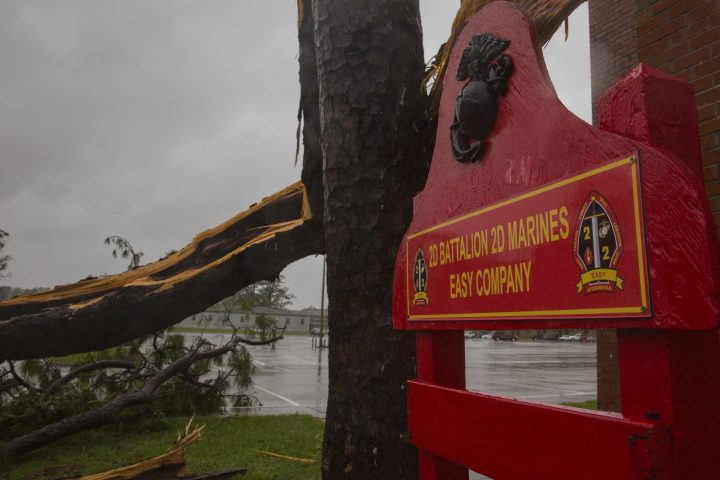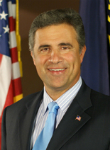
WILMINGTON – Retired Marine Corps Brig. Gen. Stephen Cheney does not sugarcoat it.
“Climate change is a national security threat,” he said.
Supporter Spotlight
His message aboard the Battleship North Carolina Tuesday took his audience on a verbal tour that spanned the globe and circled back to Wilmington, a city facing the effects of sea level rise and more frequent, stronger hurricanes.
“You’re where the rubber meets the road,” he said.
Cheney, chief executive of the American Security Project (ASP) think tank, explained that climate change is not the ultimate culprit of catastrophic weather.
It’s the carbon dioxide, or CO2, in the atmosphere that is churning up storms like Hurricane Florence and record-breaking heat. The last five years have been the hottest in recorded history.
The shift in extreme weather has already began to leave its mark around the world.
Supporter Spotlight
“It’s an accelerant to instability,” Cheney said.
He pointed to countries like Syria, where Western policymakers argue extreme drought led to mass migration to the city of Aleppo, which led to socio-economic stresses that led into the country’s descent into a civil war.
The Islamic State of Iraq and Syria, or ISIS, moved into eastern Syria in 2014 amidst the chaos of war and began gaining land and power.
On the African continent there’s Lake Chad, where the borders of Chad, Cameroon, Niger and Nigeria meet.
In the past 40 years there has been a 90 percent decline of the lake’s surface area.
“You’re where the rubber meets the road.”
Retired Marine Corps Brig. Gen. Stephen Cheney
Boko Haram Islamists have taken advantage of the region’s fragility, recruiting impoverished farmers and fishermen and basing themselves on the lake’s islands.
“Climate change didn’t cause that, but you can see the domino effect,” Cheney said.
If CO2 emissions continue to be emitted into the atmosphere at the current rate, in 20 to 30 years temperatures in Sub-Saharan Africa may reach 140 degrees, he said. Those temperatures will drive out some 20 to 30 million refugees likely to Europe, Cheney added.
One meter – a little more than 3 feet – of sea level rise in low-lying Bangladesh means that country will lose 20 percent of its coastal property and some 20 million residents displaced, he said.
“Can they house them and take care of them in Bangladesh,” Cheney asked.
Long term, the displaced will likely go somewhere else, he continued, telling his audience they can read the tea leaves and see how climate change will cause instability.
Back in the United States, military bases and stations along the coast are having to adapt to climate change.
At Naval Station Norfolk, Virginia, the world’s largest naval station, ship piers are flooding, Cheney said.
Former Marine Corps Assistant Commandant Glenn Walters last year told a congressional committee that Marine Corps Recruit Depot Parris Island, South Carolina, needs a seawall to protect it against rising seas and repeated flooding.
At Camp Lejeune, where 30 miles of shoreline “are now threatened with sea level rise,” blue tarps are still draped over roofs damaged during Hurricane Florence, Cheney said.
That September 2018 storm left $3.6 billion worth of damage on the base.
“The Marine Corps didn’t budget for that,” Cheney said.
The storm displaced military families and interrupted the deployment of a battalion.
Further inland at Fort Bragg in Fayetteville, so-called black flag days are becoming more frequent, Cheney said.
Black flags are raised when temperatures exceed 90 degrees and signal the suspension of physical training and exercise outdoors.
The aftermath of storms and high temperatures affect the military’s readiness to respond to missions, Cheney said.
“All of these bases and stations on the coast are having to adapt,” he said.
Cheney said ASP is in favor of all energy alternatives – natural gas, wind, solar, geothermal and nuclear.
The organizations goal is to take out the politics as it pushes for these alternatives.
North Carolina is second only to California in solar energy production.
North Carolina coastal counties and municipalities, including Wilmington, are beginning to take steps to prepare for sea level rise.
At the Battleship North Carolina, for example, staff are working with engineering firm Moffatt & Nichol and the National Ocean and Atmospheric Administration, or NOAA, to deal with more frequent flooding.
Battleship executive director Capt. Terry Bragg briefly talked about the $2 million Living With Water plan, which will include living shorelines and tidal marsh restoration.
In early 2013, Wilmington released its community resilience pilot project.
Together with New Hanover County and the Cape Fear Public Utility Authority, the city worked with the Environmental Protection Agency’s Office of Sustainable Communities to identify ways to reduce the vulnerability of water and wastewater infrastructure to sea level rise and more intense coastal storms.
Wilmington Mayor Bill Saffo said now is the time for leaders to step up and make investments to ensure the nation’s infrastructure is “flood ready.”
Cheney said it’s those types of initiatives that are going to make a difference.
“We are getting there,” he said. “You’re a prime example here of what the impact can be. You’re seeing the impact daily. What’s refreshing is your reaction to it. Inside the beltway, it’s just a mud fight daily. We can do things to prevent it. We’re making headway, but we’ve got a long way to go.”
Installations that appear blue on the map above are those threatened by sea level rise and flooding, ones in red are threatened by excessive heat, orange designates drought and wildfire threat, green is flash flooding, and brown is coastal erosion. Each installation is categorized by the primary threat it faces, but that does not mean that bases face only one type of threat. Source: American Security Project











